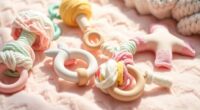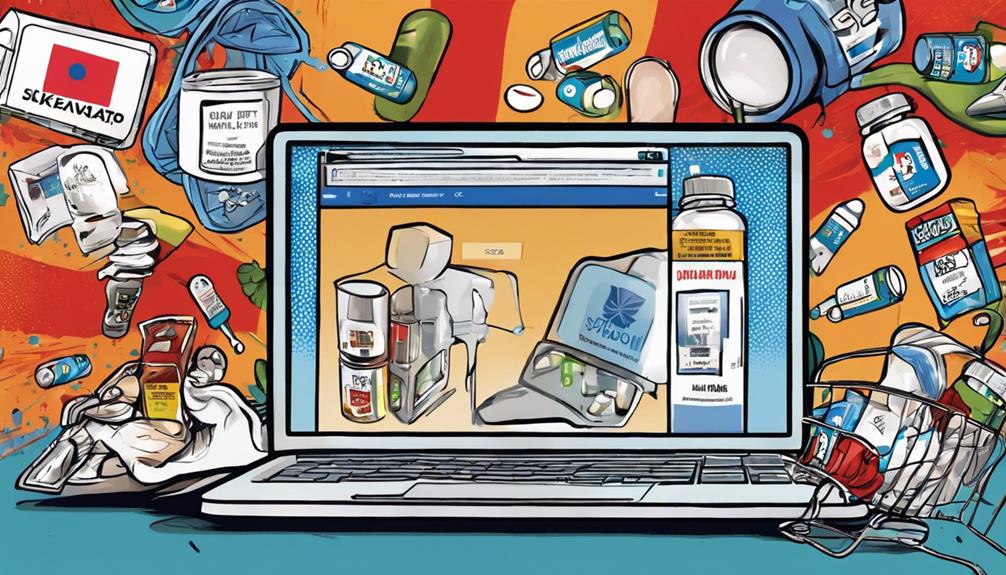You can easily engage your 2-year-old in safe, fun art projects at home that boost creativity and develop their fine motor skills. Simple activities like finger painting, bubble wrap printing, and sticker collages are perfect for little hands. You can also try edible play dough, colorful sponge painting, and nature-inspired collages. Keep supplies organized and safe, and focus on encouraging exploration. If you keep going, you’ll discover even more exciting ways to make art time enjoyable for your toddler.
Key Takeaways
- Simple activities like finger painting, bubble wrap printing, and sponge painting are engaging and safe for 2-year-olds.
- Incorporate natural materials such as leaves and flowers for easy, nature-inspired collages.
- Use edible play dough and stickers to promote fine motor skills and creativity in a safe environment.
- Encourage basic color mixing with water and food coloring to develop understanding of colors and sensory skills.
- Ensure supervision, childproof tools, and organized supplies to create a safe, enjoyable art experience at home.
Finger Painting Fun

Finger painting is a simple and exciting way to introduce your toddler to art. As they dip their fingers into vibrant paints, they begin exploring colors, textures, and shapes. This activity helps develop their toddler art skills, such as hand-eye coordination and fine motor control. You’ll find that finger painting encourages creativity without the need for brushes or special tools. Keep the environment safe and mess-friendly by covering surfaces and wearing smocks. Let your child experiment freely, encouraging them to make marks and explore different ways to use their fingers. Not only is finger painting fun, but it also boosts confidence as your little one creates their first masterpieces. Plus, it’s a wonderful opportunity for bonding and sensory exploration. Incorporating child-friendly materials can further enhance their safe artistic experience. As with many creative activities, finger painting can also serve as an introduction to early childhood development concepts, making it both fun and educational. Additionally, engaging in such sensory activities can support cognitive growth by stimulating their developing brains. Incorporating elements of mindfulness during the activity can also promote calmness and focus in your child. Moreover, understanding the importance of early childhood education can help you select activities that foster comprehensive growth.
Bubble Wrap Printing

Bubble wrap printing is a fun and easy way to introduce your toddler to printmaking and texture exploration. You can prepare for this activity by covering your workspace to make cleanup simple, especially after the mess. Let your child dip pieces of bubble wrap into washable paint, then press them onto paper to create playful patterns. This activity encourages sensory development and fine motor skills while keeping it simple. Afterward, you might rinse the bubble wrap, which ties into kitchen cleanup routines or outdoor gardening projects where supplies are easy to wash and reuse. Plus, it’s a great way to enjoy art outside on a sunny day, blending creative play with fresh air. Bubble wrap printing offers endless fun and learning for your little artist. Proper surface preparation ensures that cleanup remains quick and easy, making it more enjoyable for both you and your child. Additionally, using durable, well-draining surfaces can help prevent messes from spreading during the activity. Incorporating child-safe paints can enhance the safety and enjoyment of the activity, making it suitable for toddlers. To further enhance the experience, choosing safe, non-toxic paints ensures your child’s health while they explore their creativity.
Edible Play Dough Creations
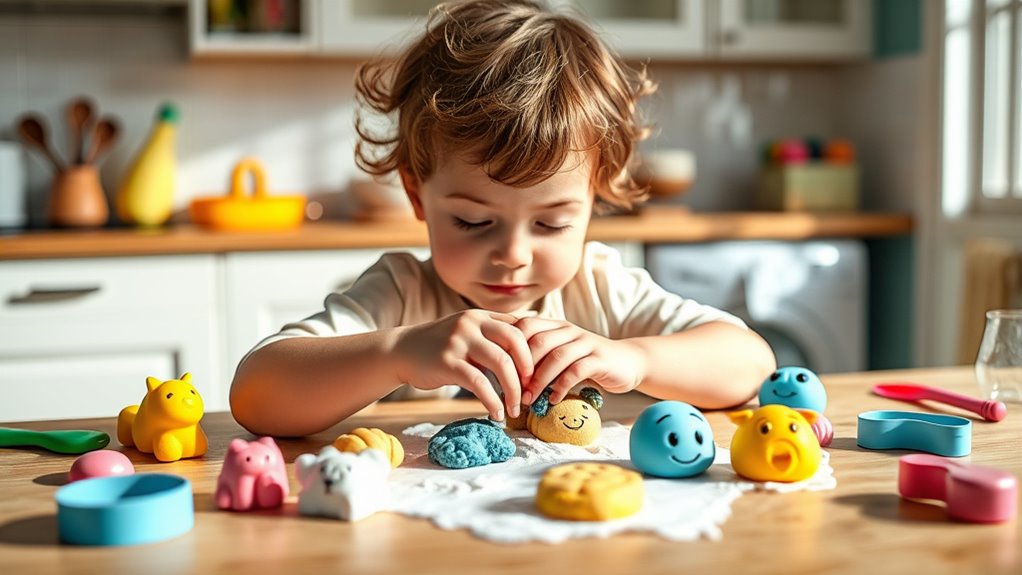
Creating edible play dough is a safe and tasty way to introduce your 2-year-old to sensory play and imaginative creation. This activity combines fun with healthy snack ideas, making it perfect for little hands exploring textures. To enhance their sensory integration techniques, you can:
- Add different flavorings like vanilla or fruit extracts for varied tastes.
- Incorporate natural colorings such as pureed fruits or vegetables.
- Encourage your child to shape and mold the dough into fun objects or animals.
Using edible ingredients like honey, flour, and salt guarantees the play dough is safe if accidentally ingested. This activity promotes fine motor skills and creativity, all while satisfying their curiosity through safe, edible fun.
Color Mixing With Water and Food Coloring
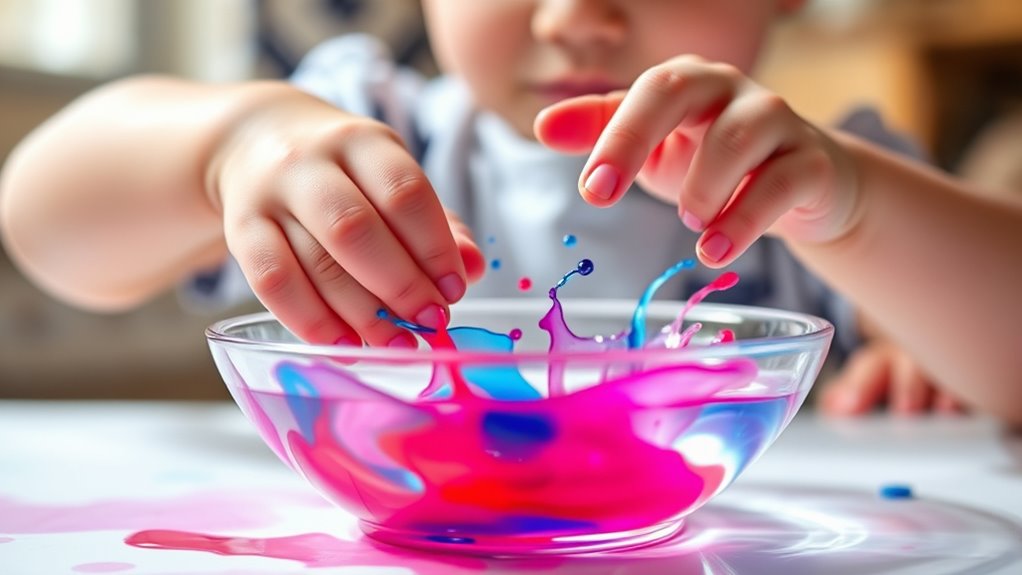
You can introduce your little one to basic color blending by mixing water and food coloring, creating new shades as they watch. This simple activity encourages safe water play while keeping them engaged in hands-on art exploration. It’s a fun way to help your toddler learn about colors while fostering their creativity. Additionally, using different shades of food coloring can help them explore color mixing and understand how colors combine in nature. Exploring child-safe materials ensures the activity remains safe and enjoyable for your toddler as they experiment with different color combinations. According to ancient wisdom emphasizing balance and harmony, this activity can also teach children about the importance of harmony in their creative expression.
Basic Color Blending
Introducing basic color blending is a fun and simple way for toddlers to explore how colors mix. Using water and food coloring, you can teach them about color mixing techniques while emphasizing primary and secondary colors. To get started:
- Show how to add a few drops of primary colors (red, blue, yellow) into separate cups of water.
- Let your child observe how mixing two primary colors creates a secondary color—like red and blue making purple.
- Encourage them to experiment by combining different colors to see new shades develop.
- This activity introduces children to fundamental color theory concepts, fostering early interest in art and science, which can also be enhanced by discussing visual perception and how we interpret colors. Understanding color mixing can deepen their appreciation for how artists use colors to convey mood and meaning.
- Engaging in these activities can also support the development of their sensory perception, helping them better understand how different stimuli influence their perception of the environment and how dog breeds can have distinct coat colors and textures.
This activity helps your toddler understand the basics of color blending while engaging their senses. Keep it playful and encourage curiosity as they discover how colors change and blend seamlessly.
Safe Water Play
Building on your child’s curiosity about color blending, safe water play offers a fun and mess-free way to explore these concepts. Fill a shallow container with water, making certain the water safety by keeping it at a comfortable, lukewarm temperature—never too hot or cold. Add a few drops of food coloring to small cups, and let your toddler dip their fingers or brushes into the colored water. As they transfer colors between cups, they see how colors blend and change. Supervise closely to prevent spills and ensure they don’t try to drink the water. Always check the water temperature before starting, and keep the activity simple and engaging. Incorporating proper supervision and safety equipment is essential to prevent accidents during water play. This safe water play encourages sensory exploration while teaching basic color mixing skills, and using safe, non-toxic supplies helps ensure a secure learning environment. Additionally, choosing high-quality honey, such as Vetted Beekeeper Honey, can introduce your child to the benefits of natural products, fostering an appreciation for wholesome foods from an early age. Incorporating fraud prevention tools such as real-time monitoring can also help ensure the safety of online activities related to learning and play. Furthermore, understanding Hyundai Tuning options can inspire curiosity about how different modifications enhance vehicle performance, paralleling the way children learn and develop new skills through safe exploration.
Creative Art Exploration
Creative art exploration with water and food coloring invites your toddler to experiment with color mixing in a simple, hands-on way. This activity supports artistic development and can even serve as gentle art therapy by encouraging self-expression. To deepen the experience, consider these steps:
- Fill clear containers with water and add different food coloring drops.
- Let your toddler use a pipette or spoon to transfer colors between containers.
- Observe how new colors emerge as they blend, fostering curiosity and understanding of color theory.
This activity promotes fine motor skills and sensory exploration while nurturing your child’s creativity. It provides a safe space for experimentation, helping them build confidence in their artistic abilities and enjoy the process of discovery.
Sticker Collage Art

When creating sticker collage art, choose safe, non-toxic stickers that are easy for little hands to handle. Try different placement ideas to encourage creativity and let your child experiment freely. Always supervise to guarantee safety and help when needed as they explore sticking and peeling.
Choosing Sticky Materials
Choosing the right sticky materials is key to a successful sticker collage art project for 2-year-olds. Start by exploring various adhesive options, like peel-and-stick stickers, double-sided tape, or glue dots, to find what works best for little hands. Proper sticky surface preparation also matters: make sure the paper or cardboard is clean and dry to help stickers adhere firmly. Consider these tips:
- Use thick, sturdy paper to withstand peeling and repositioning.
- Select non-toxic, washable adhesives for easy cleanup.
- Test small areas first to check stickiness and avoid frustration.
Creative Placement Ideas
To make sticker collage art engaging for your 2-year-old, encourage experimenting with different placement ideas that spark their imagination. Let them arrange stickers in patterns, on paper, or even on unexpected surfaces like cardboard boxes or empty jars. As they create, consider transforming their artwork into mini art gallery displays around your home, showcasing their colorful creations. This not only boosts confidence but makes the process exciting. When finished, use simple art storage solutions like folders or bins to keep their sticker collages organized. Rotating displays of their artwork can turn your space into a vibrant gallery, celebrating their creativity. By exploring various placement ideas, you foster their artistic confidence and make art time both fun and meaningful.
Safety and Supervision
Supervising your 2-year-old during sticker collage art helps guarantee they stay safe while exploring their creativity. To make certain a safe environment, implement childproofing measures like covering sharp edges, keeping small items out of reach, and using non-toxic stickers. When supervising young artists, stay close and observe their actions to prevent choking hazards or accidental ingestion. Here are some tips:
- Keep scissors, glue, and small accessories away unless supervised.
- Use washable, non-toxic supplies to minimize mess and risk.
- Establish clear boundaries, such as designated art areas, to maintain control.
Nature Collage With Leaves and Flowers
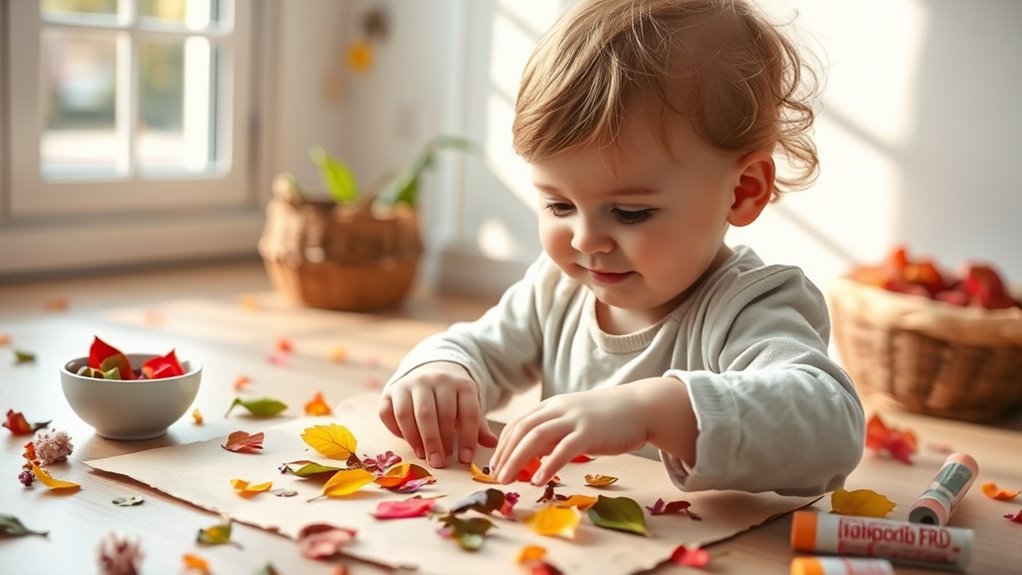
Creating a nature collage with leaves and flowers is a simple and fun way to introduce your 2-year-old to the natural world. Start with a short nature exploration walk to collect interesting leaves and flowers. Let your child pick different textures, shapes, and colors, encouraging curiosity and sensory experiences. Once home, provide a sturdy piece of paper or cardboard as a base. Show your little one how to glue the leaves and flowers onto the surface, emphasizing gentle handling. This activity helps develop fine motor skills and fosters an appreciation for nature’s beauty. Keep it relaxed and playful, praising their efforts. Your child will enjoy discovering and creating, all while learning about different plants and textures in a hands-on way.
Sponge Painting With Bright Colors
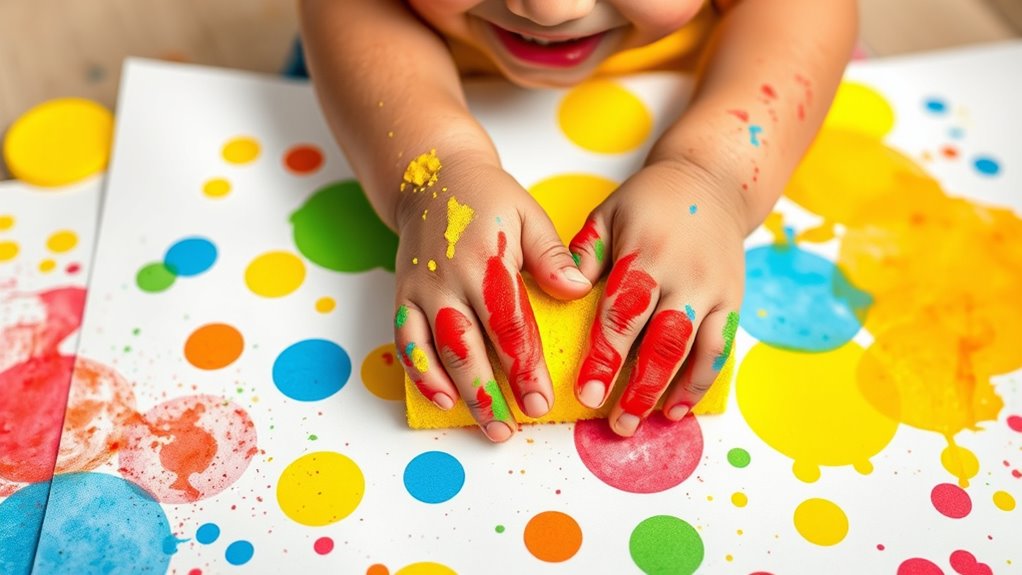
Sponge painting with bright colors is a lively and engaging activity that allows your 2-year-old to explore their creativity while developing their fine motor skills. By dabbing a sponge dipped in vibrant paint onto paper, they can create exciting texture patterns and enjoy the visual appeal of color vibrancy. To enhance the activity:
- Use different-sized sponges for varied texture patterns.
- Choose bold, bright colors to captivate their interest.
- Encourage your child to layer colors for more dynamic, colorful designs.
This process helps them understand how colors blend and encourages experimentation with textures. The tactile experience of pressing and dabbing promotes hand-eye coordination, making sponge painting a fun, sensory-rich project for your little one.
Crayon Rubbings of Textured Surfaces
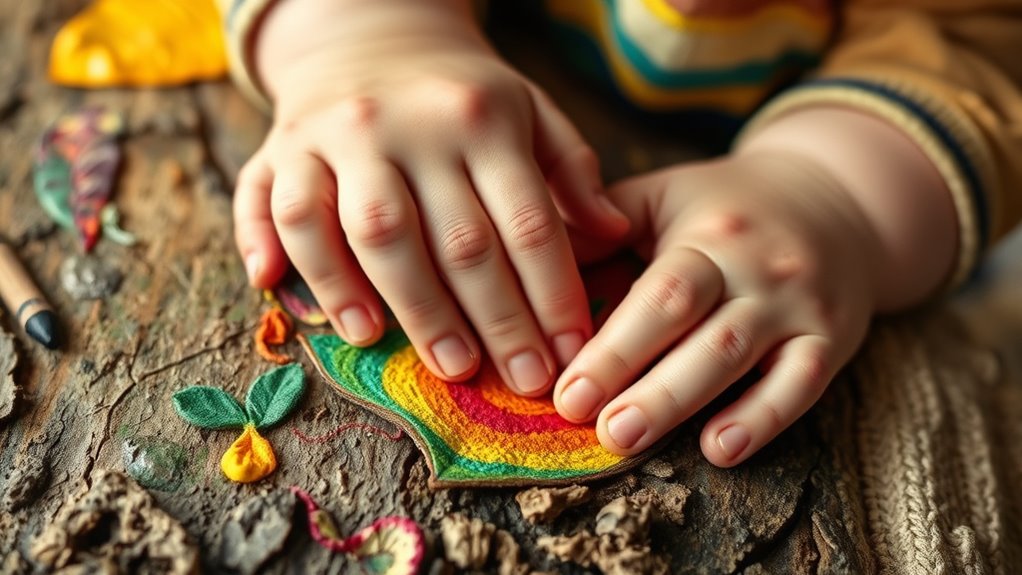
Crayon rubbings of textured surfaces are a simple yet exciting way for your 2-year-old to explore patterns and tactile sensations. As they gently move a crayon across paper placed over various textured objects, they’ll discover surface impressions and develop their sense of texture exploration. Encourage them to try different surfaces like leaves, coins, or textured fabric to see how each creates unique patterns. This activity helps improve fine motor skills and introduces them to the concept of patterns through tactile feedback. Keep the process relaxed and fun, allowing your child to experiment freely. You’ll be amazed at how they recognize and enjoy the variety of textures while creating colorful, one-of-a-kind surface impressions.
Sensory Bottles With Glitter and Paint

Sensory bottles with glitter and paint offer an enchanting way for your 2-year-old to explore colors, movement, and textures. These sensory bottles stimulate sensory exploration and provide a calming activity. To make them, gather a clear plastic bottle, glitter, waterproof paint, and water.
- Fill the bottle with water, leaving some space.
- Add glitter and a few drops of paint to create vibrant effects.
- Seal the lid tightly and secure with hot glue for safety.
Your child can shake and roll the sensory bottles, observing the glitter swirl and paint move. This activity encourages sensory exploration, enhances fine motor skills, and sparks curiosity. Sensory bottles with glitter and paint are simple, engaging projects perfect for at-home fun.
Frequently Asked Questions
What Safety Precautions Should I Take During These Art Activities?
When doing art activities with your toddler, you should prioritize safety. Always choose non-toxic paints and materials to prevent any health issues. Keep sharp scissors out of reach and supervise closely if they’re used. Guarantee the workspace is safe and clutter-free to prevent accidents. By taking these precautions, you’ll help your little one enjoy creative fun while staying safe during every art project.
How Can I Encourage Creativity Without Directing the Project?
Just as a splash of color can transform a blank canvas, encouraging your child’s free expression sparks their creativity naturally. You can create open-ended activities that allow them to explore without strict instructions, fostering independence. Offer a variety of simple materials and trust their instincts. When you step back and let them lead, you’ll see their imagination flourish, turning art into a joyful discovery rather than a guided task.
Are There Any Age-Appropriate Tools or Supplies Recommended?
You should choose age-appropriate supplies and safe art materials to guarantee your toddler’s safety and encourage exploration. Look for chunky crayons, washable paints, and non-toxic markers designed for little hands. Avoid small items that pose choking hazards and opt for sturdy, easy-to-clean surfaces. Using these safe, age-appropriate supplies helps your child enjoy creating freely while you feel confident in their safety.
How Do I Handle Mess and Cleanup Effectively?
Ever wonder how to make mess management easier? When handling cleanup strategies, set up a designated art area with washable supplies and use a splash mat or old newspaper to catch spills. Keep wipes or a damp cloth nearby for quick cleanup, and involve your toddler in tidying up—they love to help! This way, you maintain a calmer environment and teach your child responsibility through simple cleanup routines.
What Are Some Tips for Engaging a Reluctant 2-Year-Old in Art?
To engage a reluctant 2-year-old in art, try using positive reinforcement to encourage their efforts and make the activity fun. Incorporate sensory exploration by offering different textures and colors, which can spark curiosity. Keep sessions short and relaxed, allowing them to explore at their own pace. Remember, patience is key—praise their creativity and celebrate small successes to build confidence and foster a love for art.
Conclusion
With these simple art projects, you’ll turn your little one’s tiny hands into creative superheroes, transforming your home into a bustling art gallery! Watch as their imagination explodes like fireworks, and their tiny masterpieces become priceless treasures. Get ready for a rainbow explosion of giggles, messes, and unforgettable memories. Because when it comes to art with your 2-year-old, the only limit is how big their imagination can dream—so jump in and let the fun begin!


